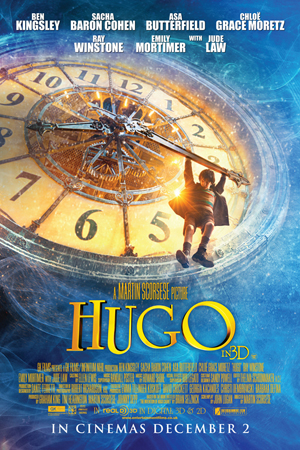Hugo (3D) ***
 Many name James Cameron as the man at the forefront of 3D. But Hugo (3D) has just added another exciting contender in one of the most unlikely directors, Martin Scorsese, who is best known for chronicling the rough and gangster-ready parts of urban America, with such greats as Taxi Driver, Goodfellas and The Departed. The artistic, colourful and quite magic wizardry of Hugo is perhaps a shock departure from the Scorsese norm – maybe like many actors, he wants to start creating films he can share with his family?
Many name James Cameron as the man at the forefront of 3D. But Hugo (3D) has just added another exciting contender in one of the most unlikely directors, Martin Scorsese, who is best known for chronicling the rough and gangster-ready parts of urban America, with such greats as Taxi Driver, Goodfellas and The Departed. The artistic, colourful and quite magic wizardry of Hugo is perhaps a shock departure from the Scorsese norm – maybe like many actors, he wants to start creating films he can share with his family?
Based on Brian Selznick’s book, The Invention of Hugo Cabret, a young orphan boy called Hugo Cabret (The Boy in the Striped Pyjamas’s star Asa Butterfield) is left to live rough and run the railway station clocks of the Gare Montparnasse, after his drunk of an uncle, Claude (Ray Winstone) goes astray. All Hugo dreams of is getting the one inheritance from his clock-maker father (Jude Law) working again, a broken mechanical automaton that could hold an invaluable message or memory from happier times.
One day, he is caught one day stealing parts from local toymaker Papa Georges’s (Ben Kingsley) stand and is father’s ideas pocketbook is taken from him. Desperate to get it back from Papa Georges, while avoiding being caught by the station inspector (Sacha Baron Cohen), Hugo meets Papa Georges’s daughter Isabelle (Chloë Grace Moretz) who holds the heart-shaped key that he needs to wind up the automaton. However, once the two join forces, they discover a whole new world of secrets about Papa Georges’s past.
The first awe-inspiring moment is being whirled along – like through a fly’s eye – on a gravity-defying trajectory through the station platforms and concourse that has to be seen to be believed. Scorsese’s whole 3D affair is a sumptuous one of artistic marvel that has a wintry festive glow to it. There is so much scene detail to take in it’s quite breathtaking in fact, like pouring over the illustrative brilliance of an old-fashioned storybook.
Scorsese sets up his characters and their settings well, giving insights into what makes them tick and what ticks them off, all within the period context of 1930s Paris. And while we are thrilled by this and invest in the romance of the time, as well as the promise of a child-led adventure with Hugo and Isabelle, the non-cinephile among us might find the latter half of the film rather obsessive as it veers off into cinema history to not only serve Scorsese’s gratification, but also to hammer home his work with The Film Foundation, an organisation that campaigns for motion picture preservation. It’s here the younger viewer might find things a little bit of a slog, regardless of the cinema magic on show.
Indeed, as we begin to lose track of Hugo’s own adventure a little, we certainly hear Scorsese cries of his organisation’s aim through this part of the narrative, and much as his creative indulgence into the visionary entrepreneurism of cinematic forefathers’ The Lumière brothers, Harold Lloyd and Georges Méliès may mean more to some while educating others, the eventual reasons for this tangent take some time to materialise.
Still, the performances are nothing short of compelling, with child leads Butterfield and Moretz illuminating the screen, especially a confident Moretz as headstrong Isabelle, without falling into the standard, overacted and dewy-eyed portrayals in other kids films. Baron Cohen is his usual comedic self, like a contemporary-talking cross between Inspector Clouseau and Officer Crabtree from TV’s ‘Allo ‘Allo! series. But for full effect to demonstrate Scorsese’s awe at the work of Méliès, the director has cast the enigmatic Sir Kingsley as Papa Georges to capture both this character’s long-held bitterness and his majestic transition at the end of the film. Kingsley’s acting dexterity is reborn in this, after the disappointing Prince of Persia: The Sands of Time last year.
Hugo (3D) is a sumptuously crafted film that underlies Scorsese’s aims of touching hearts, taking us to other places and providing us with striking visual memories. Like all family entertainment, it has its wholesome moral values at its core. Even though the journey to the grand reveal meanders while doubling as a parallel Scorsese campaign for film preservation, the director has produced one of the most strikingly visual films of 2011 and demonstrated a correct use of live-action/animated 3D.
3/5 stars
By @FilmGazer